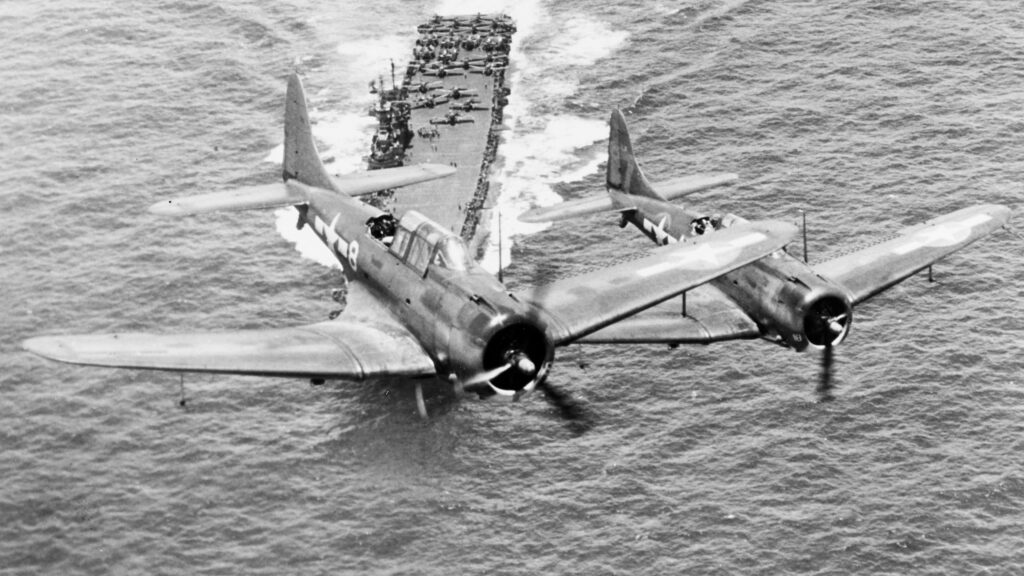
There were many military platforms in history that have been described as the “right tool” for the job. The Douglas SBD Dauntless dive-bomber arguably was not exactly one of those. It was underpowered and vulnerable, and it lacked range. Pilots said it was exhausting to fly for any length of time, and it was already showing its age even as the war in the Pacific was beginning.
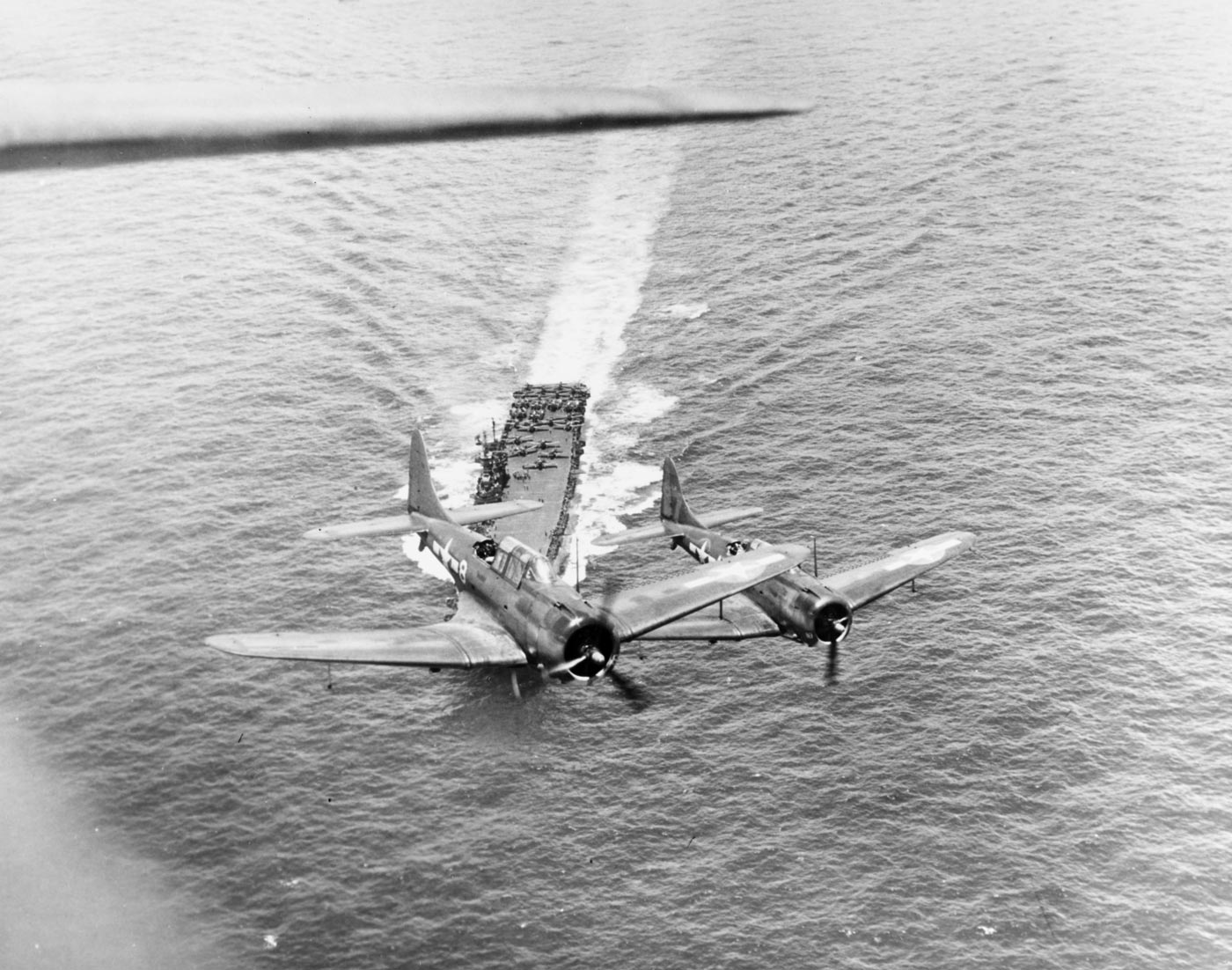
A pair of Douglas SBD-5 bombers fly past their carrier in November 1943. The photo was taken by a Naval Air Station Weeksville airship. Image: U.S. Navy
Yet, the contributions of the venerable Dauntless to victory in a succession of key naval battles cannot be overstated — while its tally of Japanese shipping during the Second World War was simply unmatched. The dive-bomber accounted for half of all U.S. carrier aircraft in the first year of the war, and the SBD was central to the U.S. Navy’s successes at the Battles of Coral Sea, Midway and the Solomons.
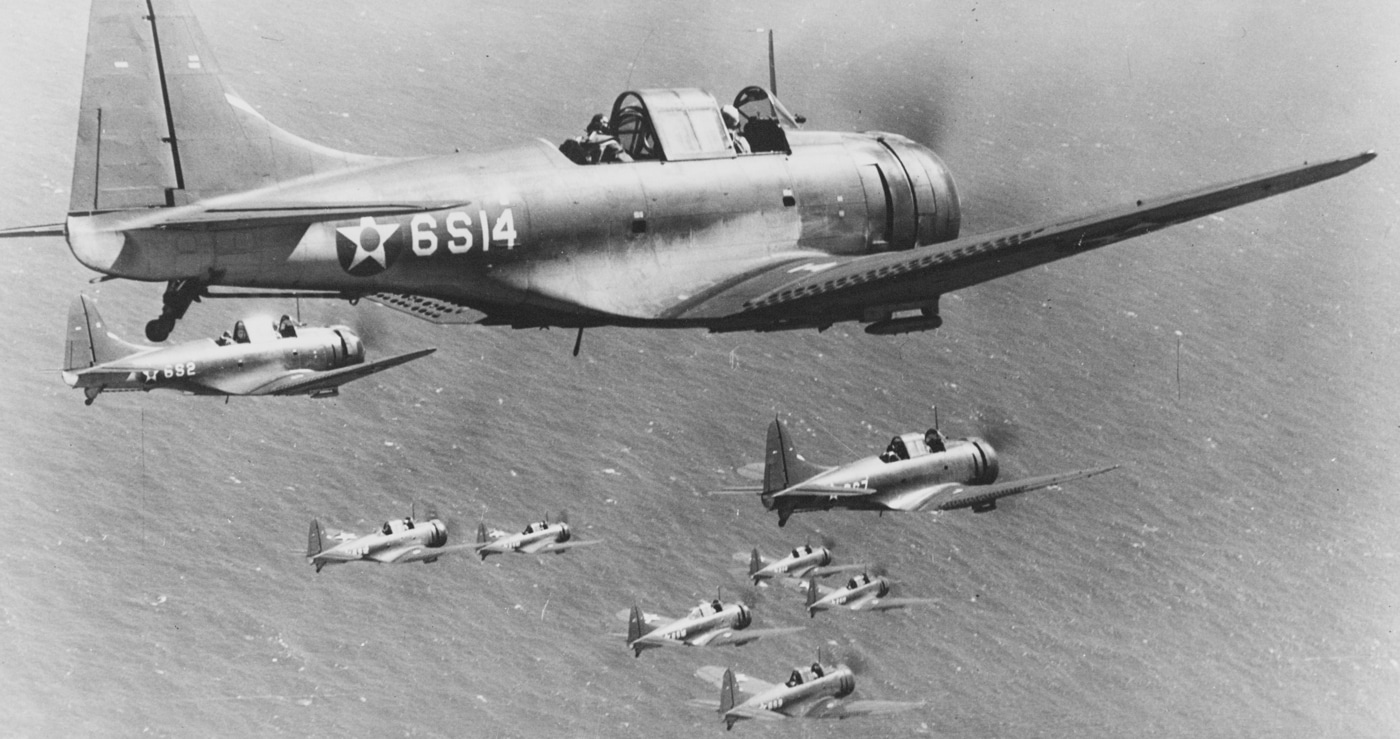
Nine Douglas SBD-2 Dauntless scout bombers, of Scouting Squadron Six (VS-6) fly in formation. Image: U.S. Navy
The Dauntless was arguably an example of making do with the tools on hand — and it is a testament to the U.S. Navy and USMC aviators who flew the warbird.
With more than eight decades of hindsight it is easy to see the Douglas SBD Dauntless as antiquated — but also why even then it was often known as “Slow But Deadly.” Yet, it was also developed during a time of great innovation and massive leaps forward. In actuality, the SBD was as much revolutionary as it was evolutionary.
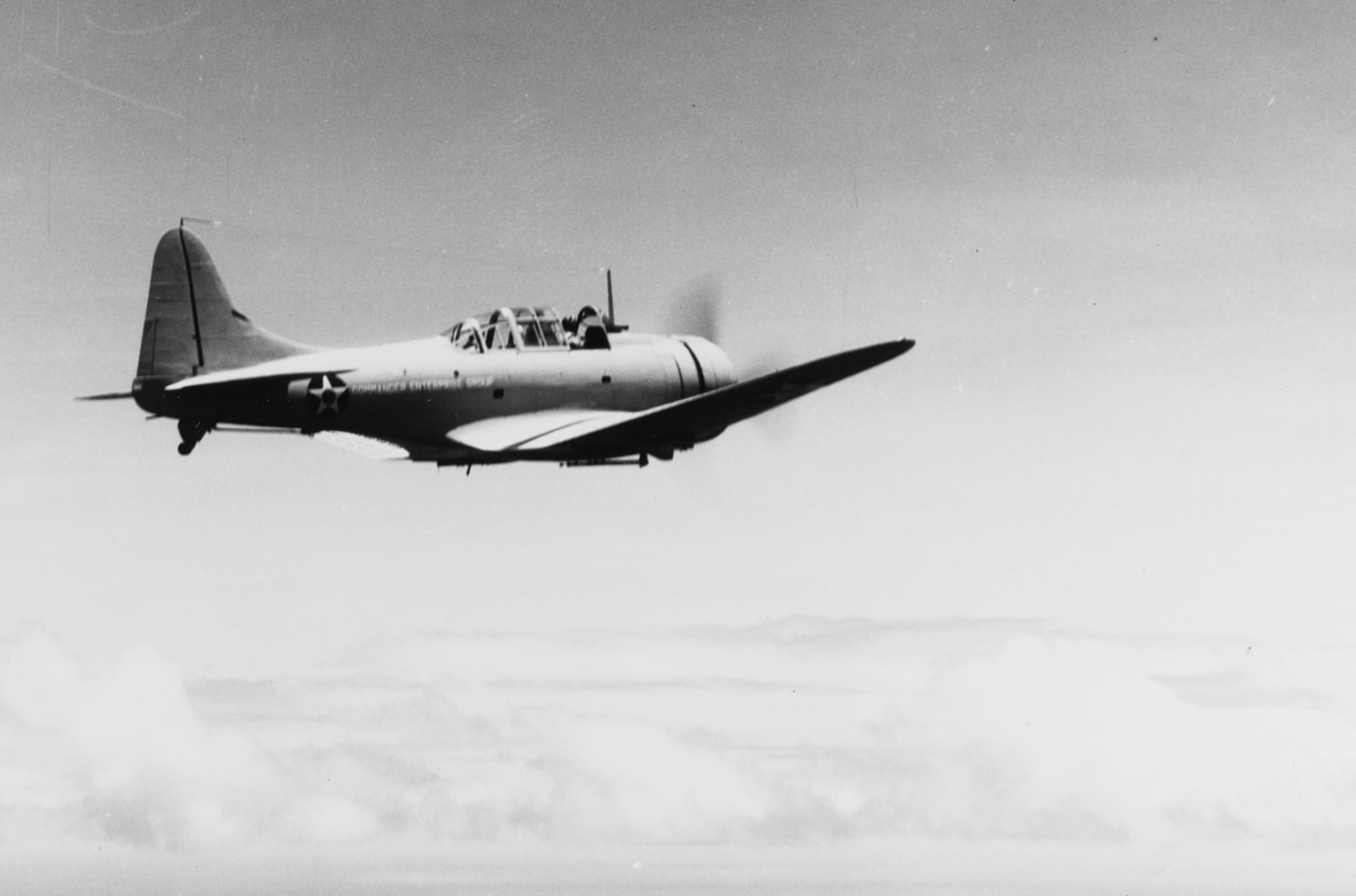
Douglas SBD-2 Dauntless scout bomber In flight over the Pacific in mid-1941. This is the USS Enterprise (CV-6) Air Group Commander’s aircraft, wearing a light grey color scheme. Image: U.S. Navy
The aircraft owed its origin to the low-wing, two-seat tandem Northrop BT-1 dive-bomber that was envisioned by Jack Northrop in the mid-1930s. However, when the El Segundo, California manufacturer became a division of Douglas with Northrop’s departure, the BT-1’s development was taken over by Edward H. Heinemann, another notable airplane visionary.
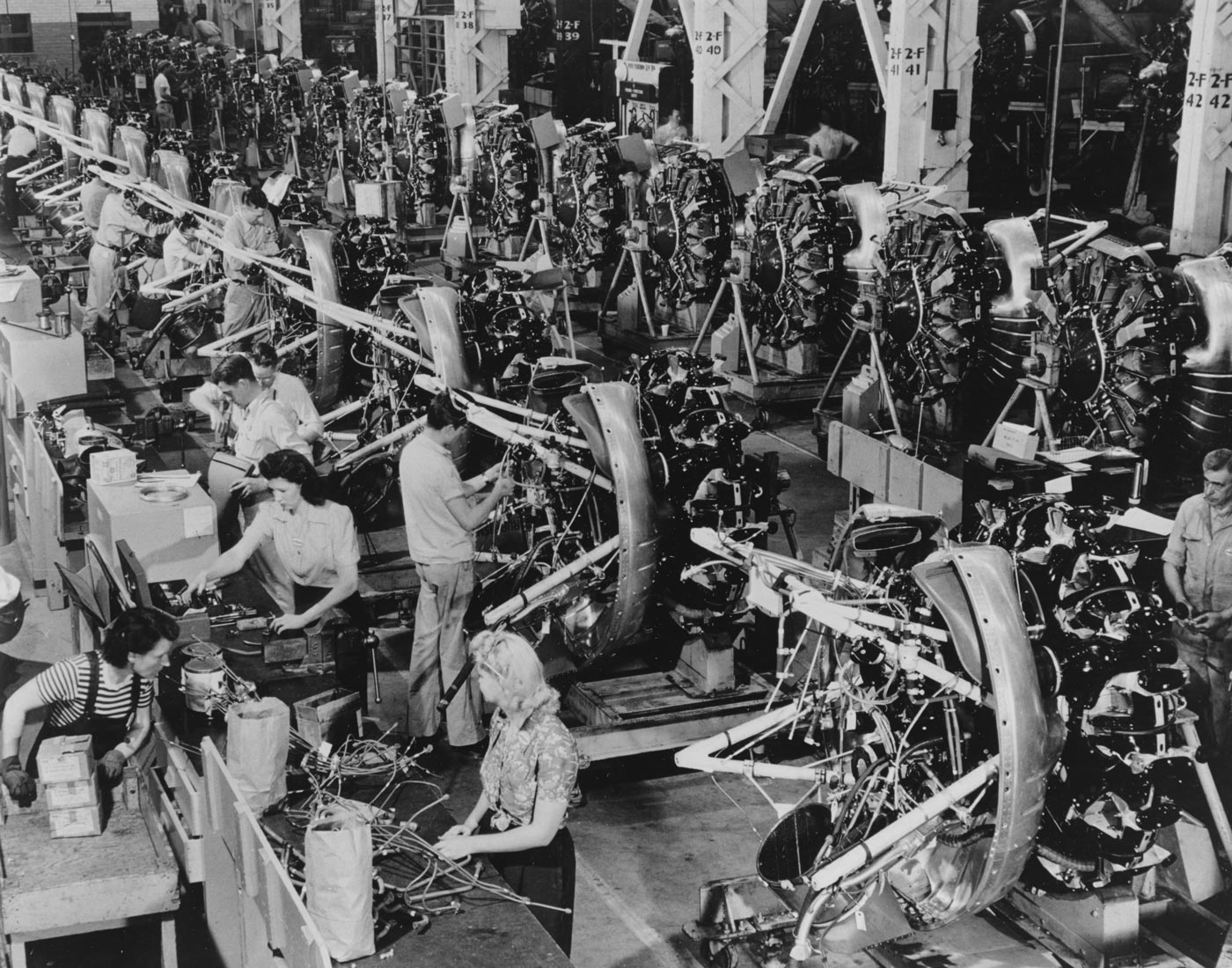
Wright R-1820 engines on the SBD production line at the Douglas aircraft plant in El Segundo, Calif., August 1943. Image: Lt. Charles F. Jacobs/U.S. Navy
The design was reworked, and the ensuing aircraft featured perforated split flaps and main gears folding backward into large fairings. Both fin and tailplane employed stressed-skin construction, while elevators and rudders were fabric covered. Tabs were further provided on the control surfaces of the tail.
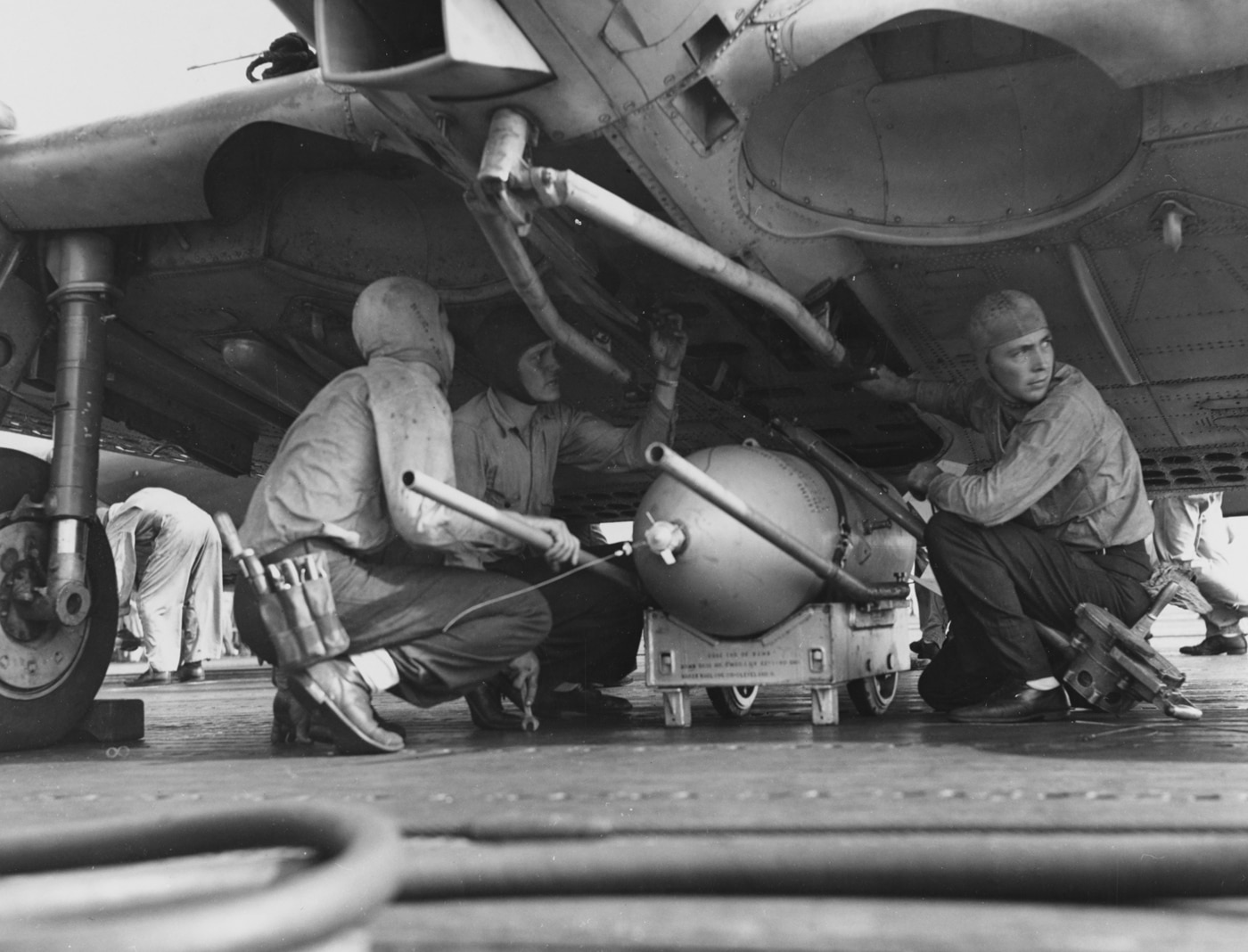
Ordnancemen of load a 500-pound bomb on an SBD scout bomber on the flight deck of USS Enterprise (CV-6) during the first day of strikes on Guadalcanal and Tulagi, August 7, 1942. Image: U.S. Navy
The result was hardly the most modern of aircraft, even in the late 1930s, but the SBD — which was accepted by the U.S. Navy even as parallel work was underway on the Curtiss SB2C Helldiver — became the standard by which all other carrier-borne dive bombers (“scout bombers” in the Navy jargon of the era), were to be judged.
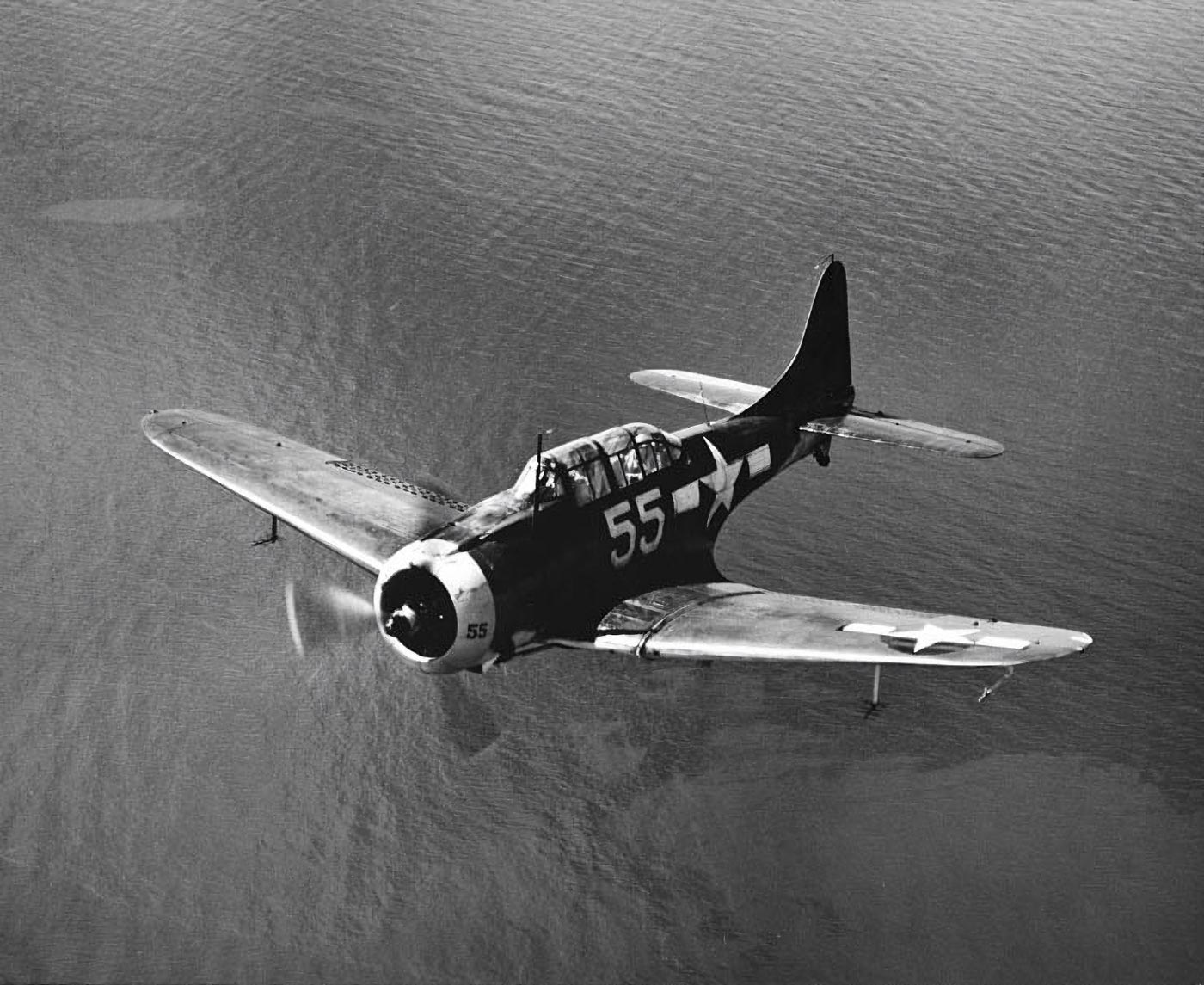
A Douglas SBD Dauntless Scout-Bomber aircraft In flight, circa 1943-1944. Image: U.S. Naval History and Heritage Command collection
The original SBD-1 was powered by the R-1820-32 Cyclone engine that developed 746kW (1,000 hp) on take-off. An intake atop the engine cowling provided carburetor cooling air. Pilots were provided with a three-power telescopic sight that protruded through the windscreen, and it could be employed for both gun- and bomb-aiming.
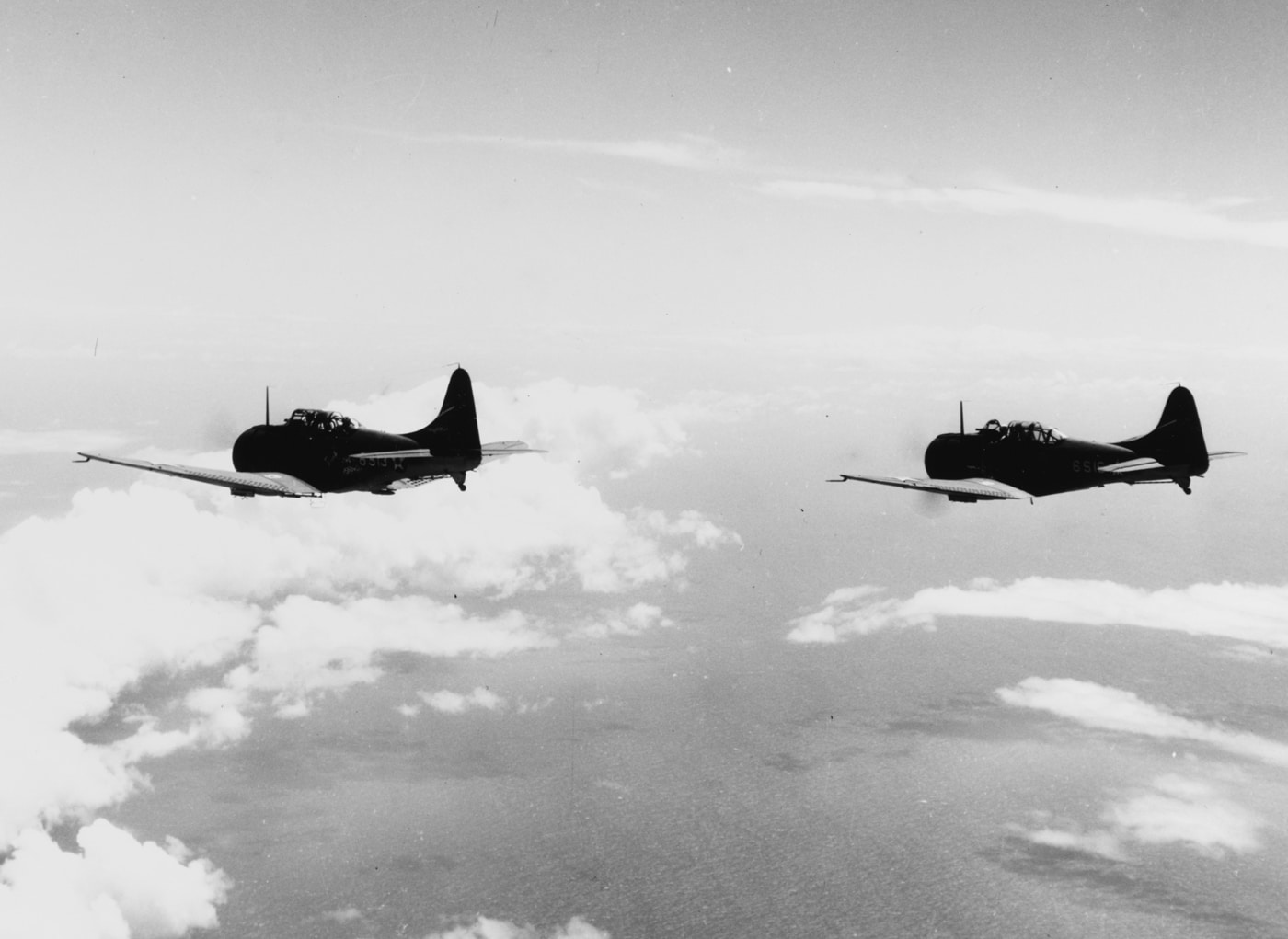
Douglas SBD-2 Dauntless scout bombers From Scouting Squadron Six (VS-6), based aboard USS Enterprise (CV-6), in flight over the Pacific in late 1941. Image: U.S. Navy
Underwing pylons could carry 45kg (100 pounds) bombs, while the main store was carried under the aircraft’s center section. It had a maximum weight of 725kg (1,600 pounds). On dive-bombing missions, the pilot approached the target at 15,000 to 20,000 feet (4,570 to 6,095 meters), took position almost overhead, flew into a deep dive and then pulled up the nose, deploying the upper and lower dive flaps where it “rolled in” with the aircraft essentially aiming the bomb load by literally pointing the plane at the target.
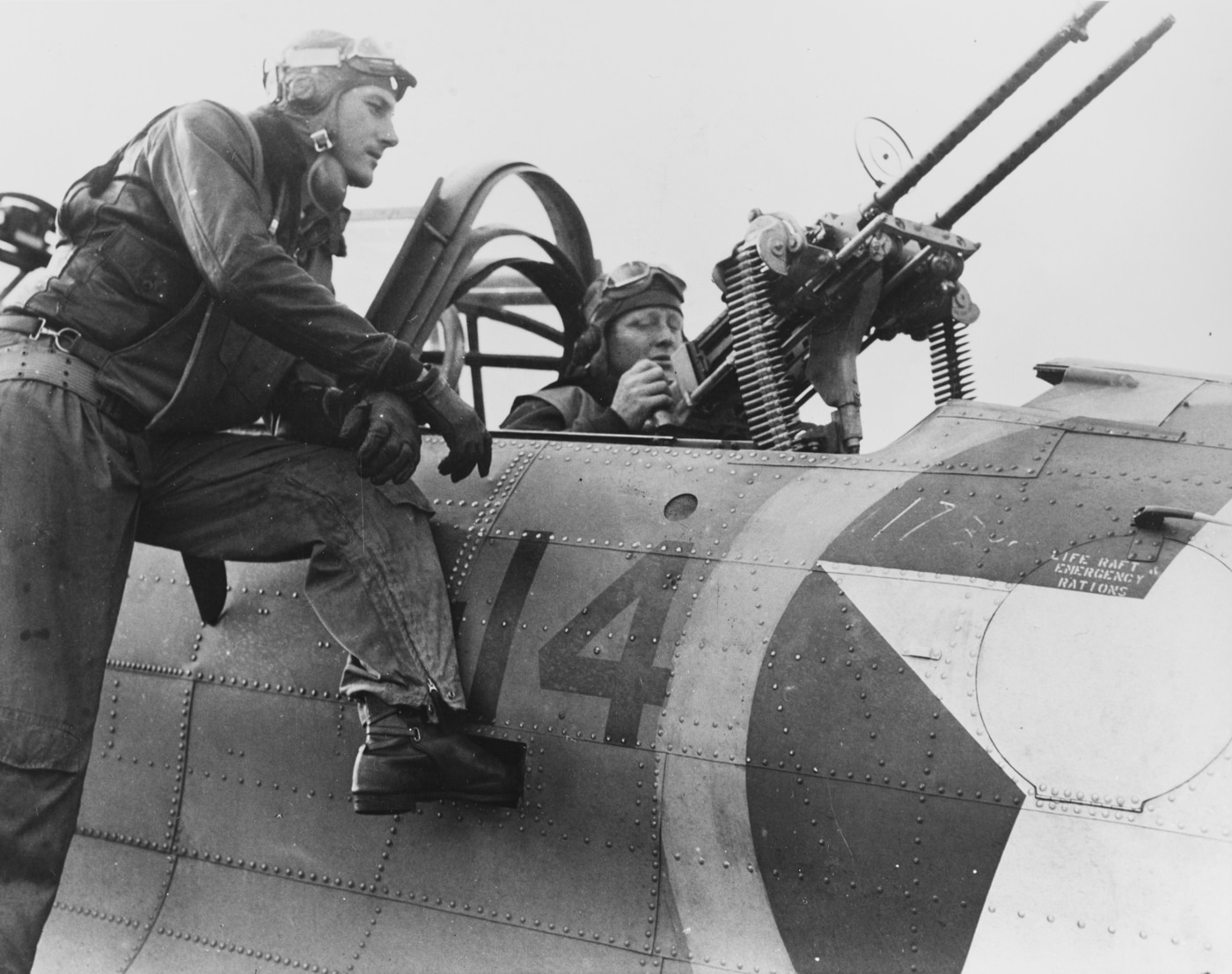
Lt. j.g. W. L. McVay (L) watches ARM2C K. W. Jobe check the dual .30-caliber machine guns in their Douglas SBD-3 during Operation Torch aboard USS Ranger (CV-4). Image: U.S. Navy
That could, and often did result in “target fascination” where the pilot could be lulled into such a state that he failed to pull out of the dive in time. However, experienced pilots could make it look almost easy with just the right motion on the stick. The destruction of multiple Japanese aircraft carriers and dozens of other ships is certainly proof that the SBD Dauntless could accomplish its primary mission.
As the development of the aircraft was being completed, Douglas won orders from both the United States Marine Corps and the United States Navy. The Dauntless went into production in June 1940, and the first SBD-1s were delivered to the United States Marine Corps within just months. The initial aircraft, which was not cleared for carrier operations, was armed with two forward-facing .50 caliber machine guns in the engine cowling and a single .30 caliber machine gun for the radio operator/gunner who sat with his back to the pilot.
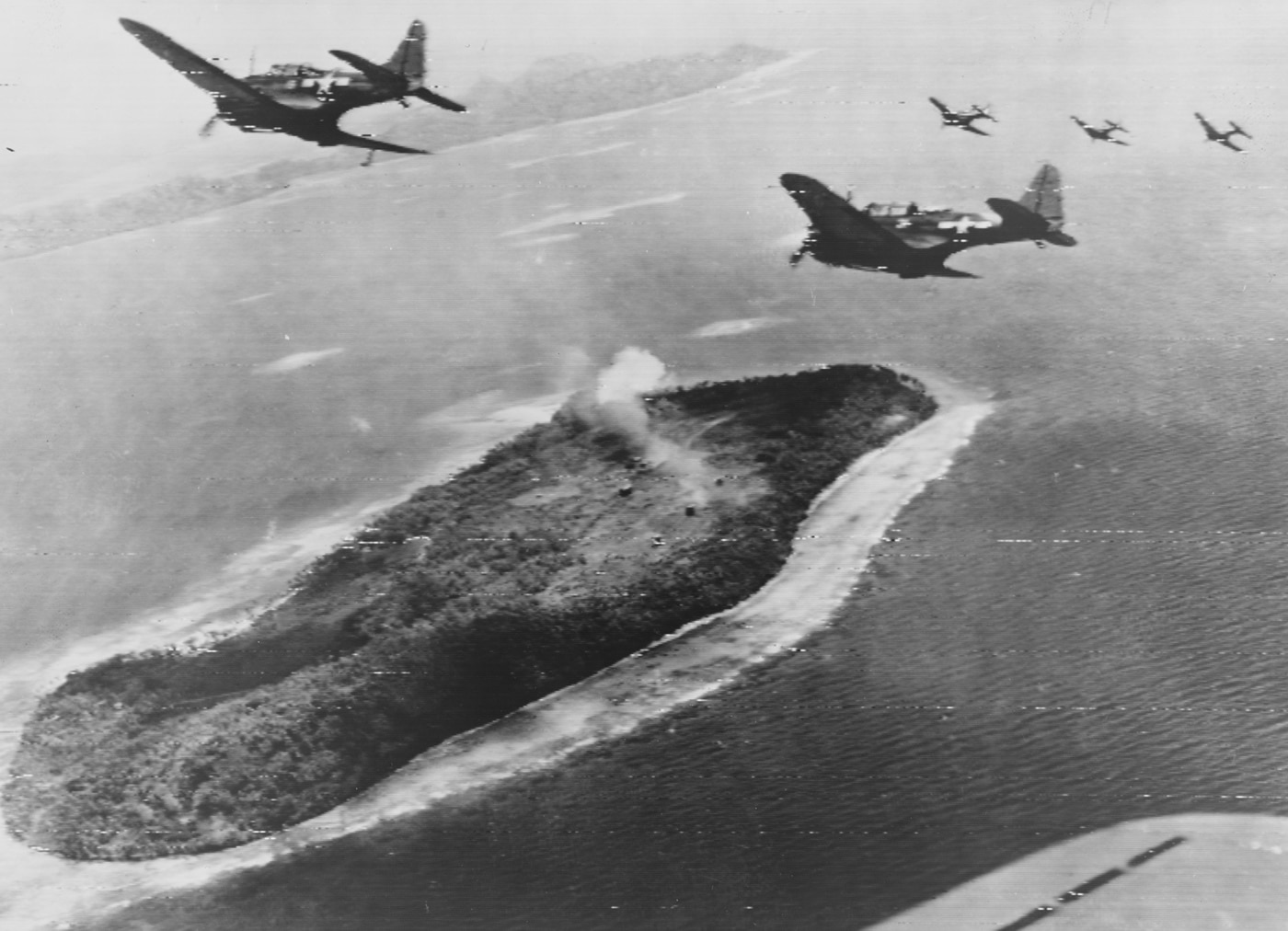
Five SBD’s from a Navy carrier peel off for a strafing attack on a Japanese radio station on Ulalu Island, Truk Atoll, in the strike of April 29-30, 1944. Image: U.S. Navy
The U.S. Navy received the SBD-2, which differed in having self-sealing, rubber-lined, metal fuel tanks and two additional 65-gallon (246 liters) tanks in the outwing panels. The first of the U.S. Navy’s aircraft was delivered beginning in December 1940. The version was also the first to be equipped with automatic piloting according to Jane’s Fighting Aircraft of World War II (Jane’s Publishing Company 1946/47).
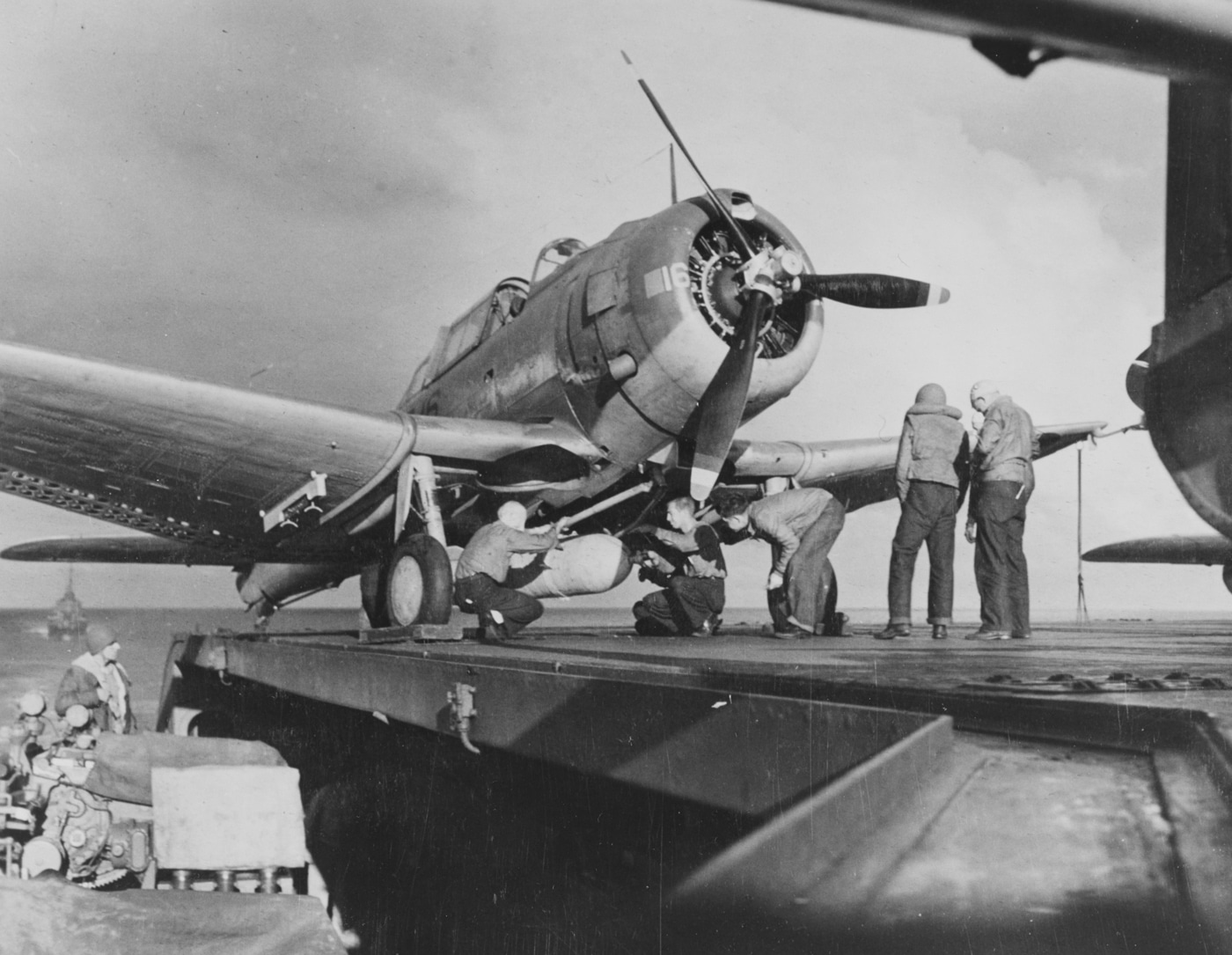
On the USS Ranger (CV-4), sailors mount a 1000-pound bomb on a SBD-3 during Operation Torch in November 1942. Canvas duck covers are in use on the carrier’s 5″ gun on the left. Image: U.S. Navy
It is noteworthy that actions not in the Pacific but in Europe factored into the evolution of the Dauntless. Washington witnessed with great shock how Germany’s Ju 87 Stuka dive-bombers were employed to great effect, and that spurred the U.S. Navy to increase its order but also to improve the capabilities of the SBD.
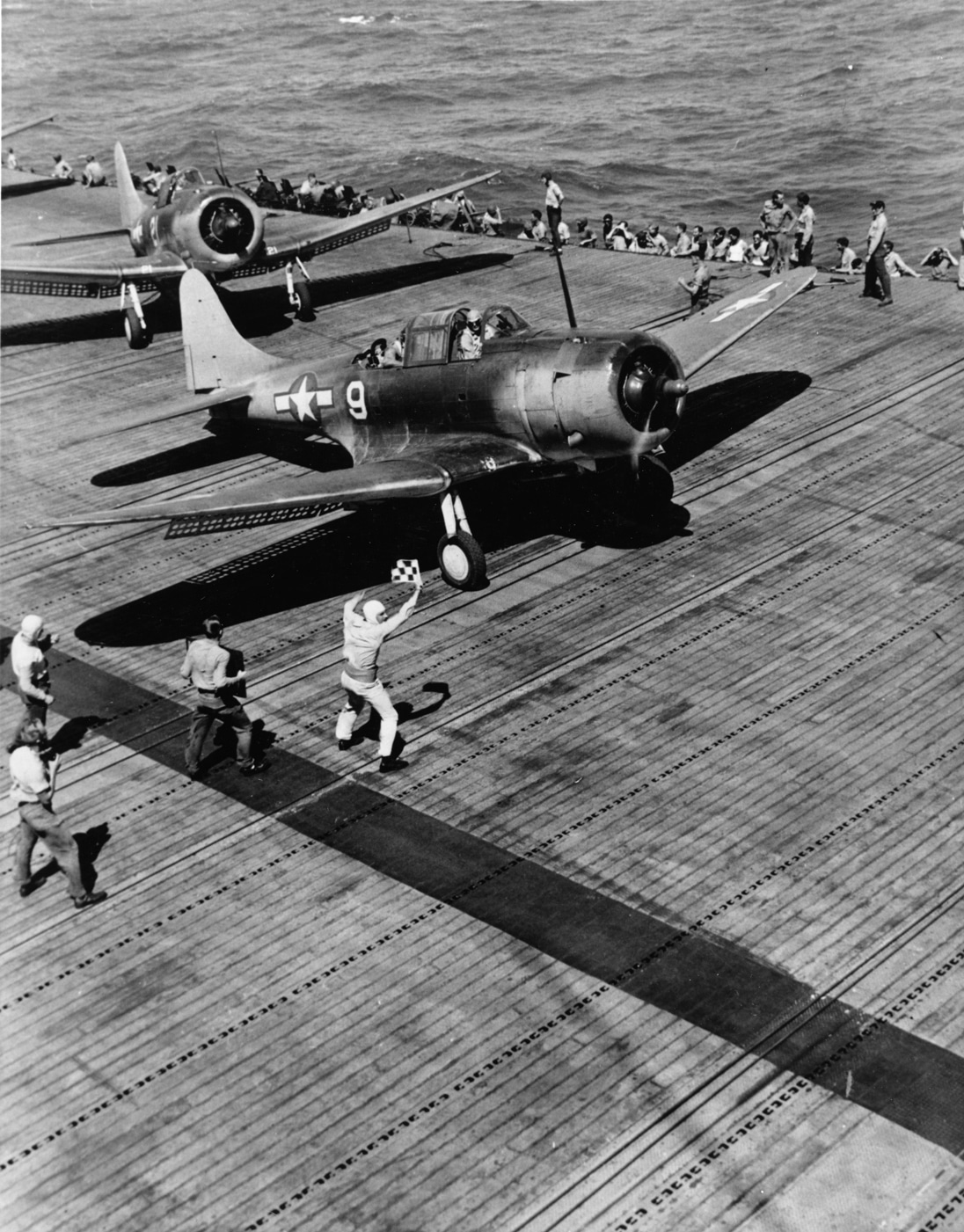
A Douglas SBD-5 on the flight deck of USS Yorktown (CV-10) awaits the take-off signal during a raid on a Japanese base, 1 September — 6 October 1943. Image: U.S. Navy
The SBD-3 was equipped with a more powerful Wright R-1820-52 engine, while it featured aluminum fuel tanks and self-sealing liners. It had essentially the same armament, but with a pair of .30-caliber machine guns for the gunner, along with additional armor protection and a “bullet-proof” windscreen, according to Jane’s. It became the standard carrier-borne dive bomber with the United States Navy by December 1941, and for two years it fulfilled the entire “scout dive-bomber” requirement for naval operations in the Pacific.
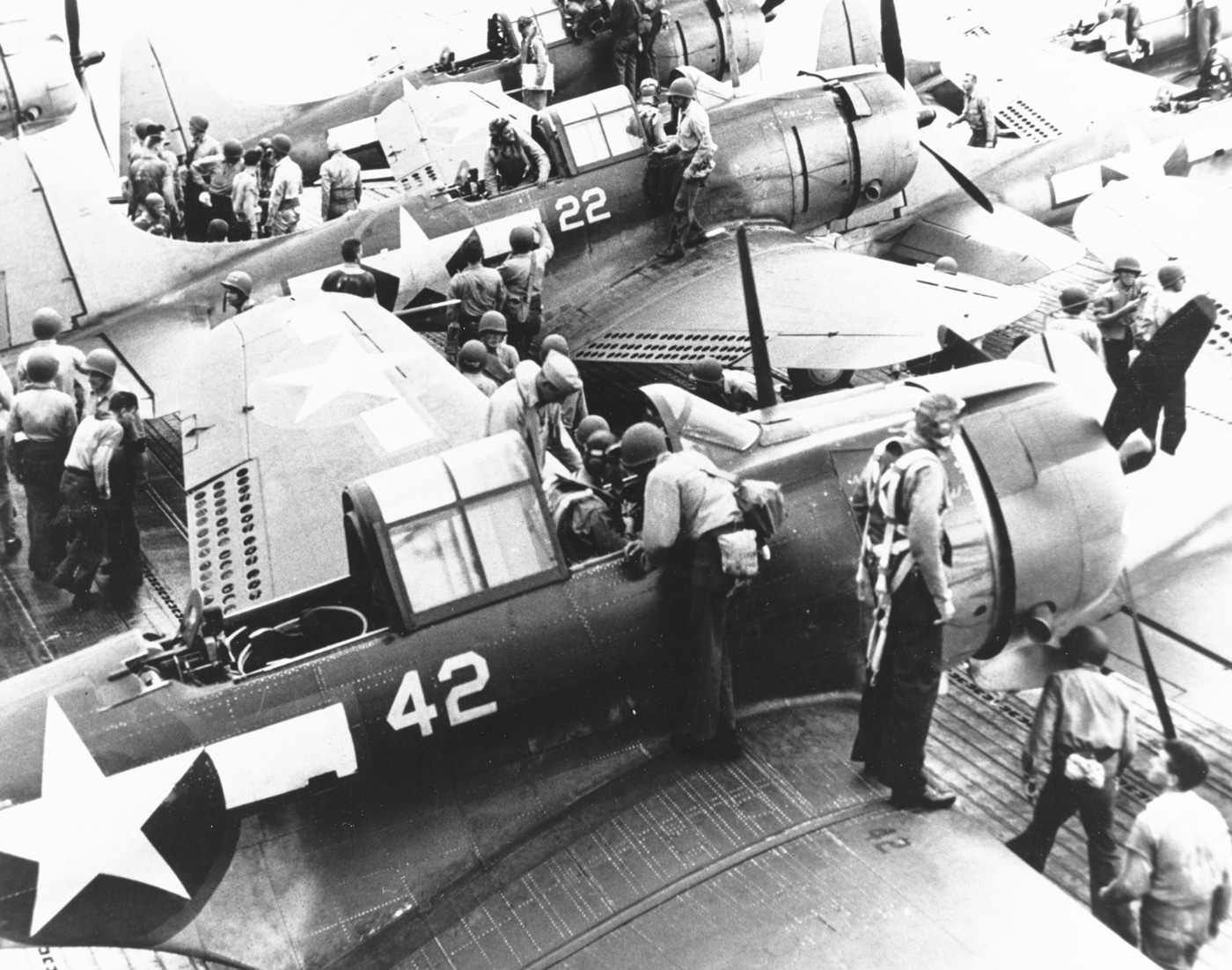
The subsequent SBD-4, SBD-5 and SBD-6 variants saw additional improvements, with the latter two models being equipped with slightly more powerful engines. These models entered service just as the Dauntless was being superseded by more modern and capable aircraft.
As employed aboard the U.S. Navy aircraft carriers during the war, the SBD Dauntless was generally assigned to one bombing squadron (VB designation) and one scout squadron (VS), which formed the overall air wing that also included two squadrons of fighters and one of torpedo bombers. In practice, however, both the VB and VS units shared similar tasks.
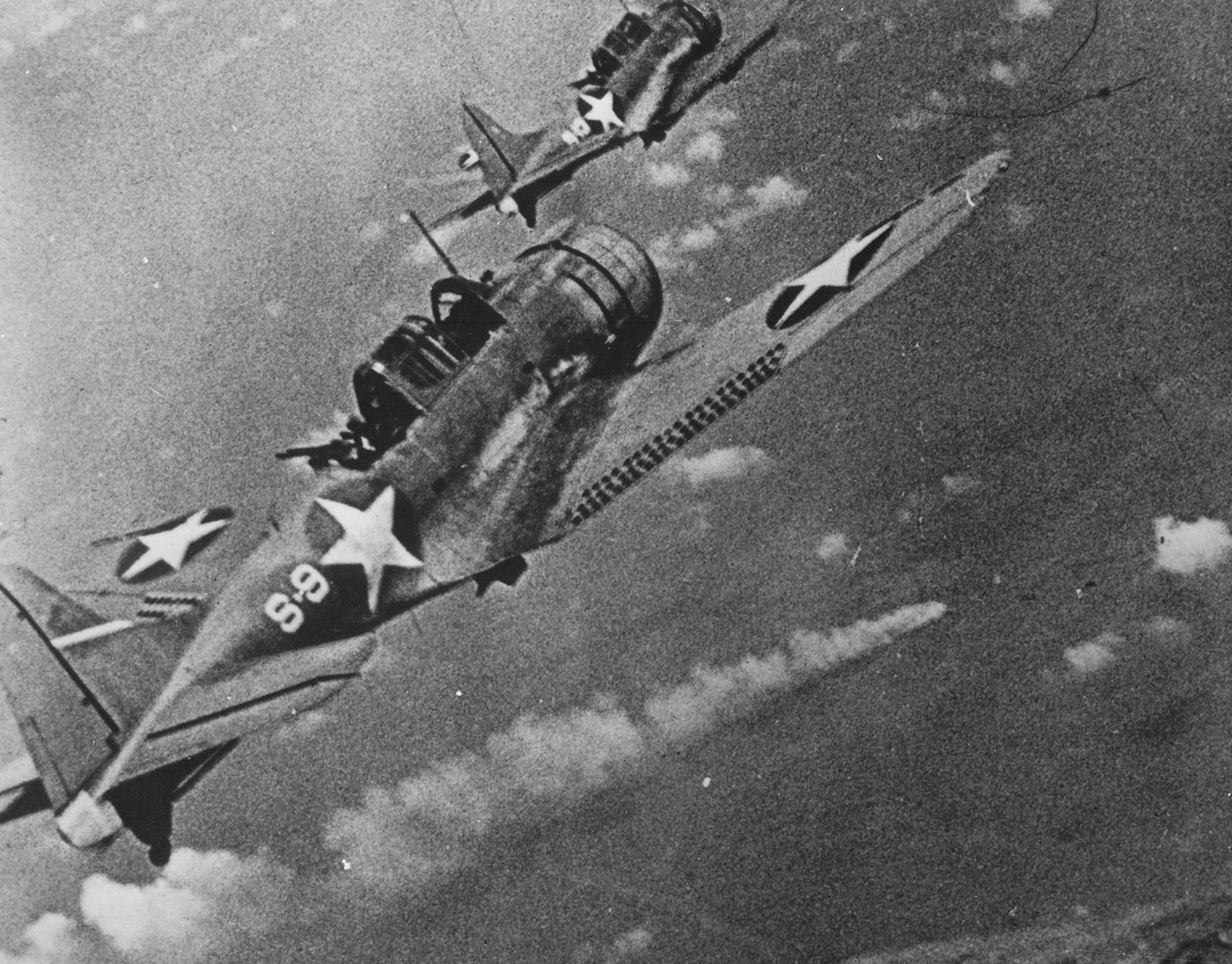
At the Battle of Coral Sea in May 1942, SBD-2 and SBD-3 models from USS Yorktown (CV-5) combined with Douglas TBD-1 Devastator torpedo-bombers, succeeded in sinking the Imperial Japanese Navy’s aircraft carrier Shōhō after a 30-minute-long engagement, with the loss of just three U.S. aircraft.
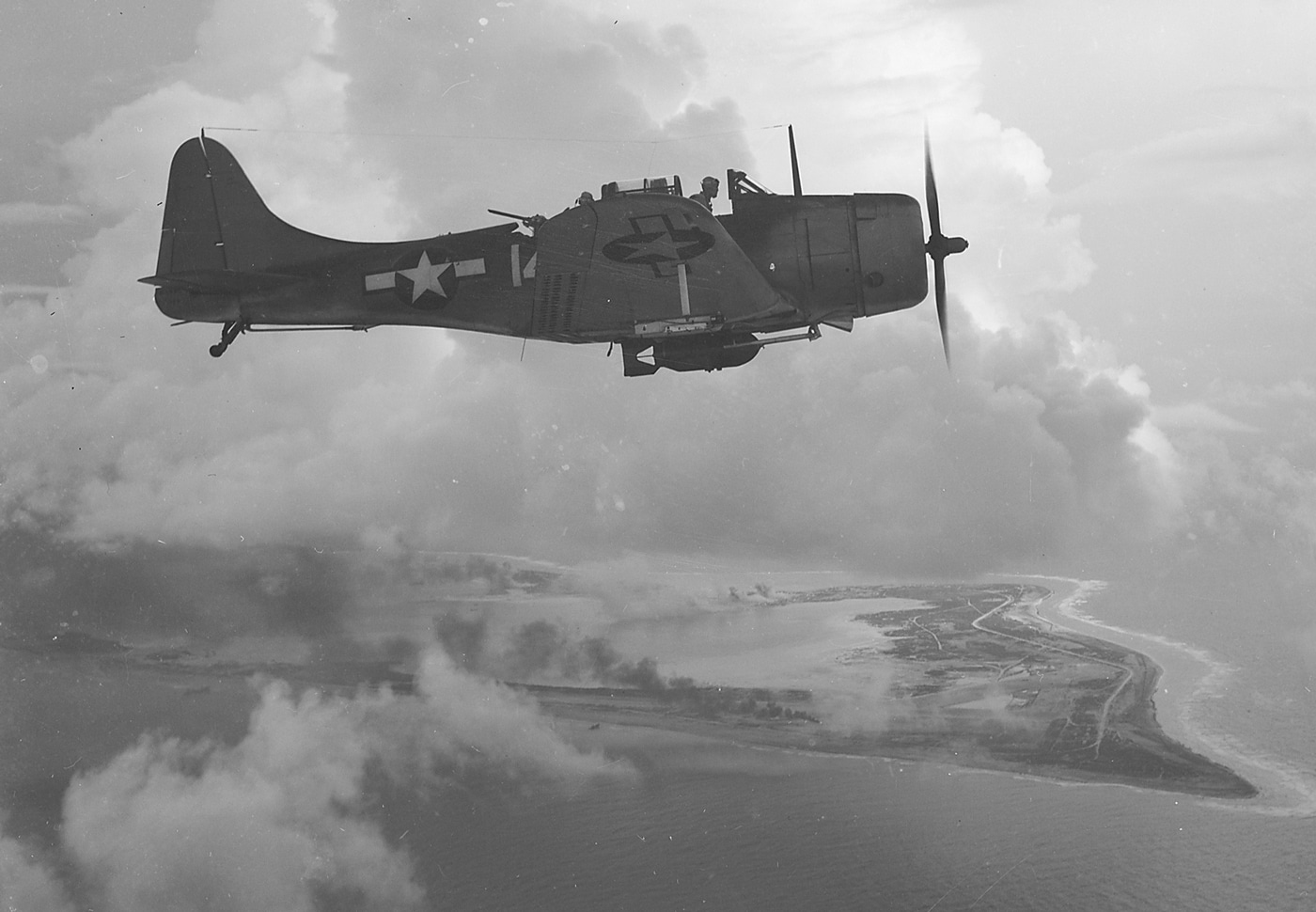
During the subsequent Battle of Midway in June 1942, the Dauntless played a pivotal role — when a force of 128 of the aging warbirds launched from the decks of the American carrier groups. They sought to find the carriers of Admiral Isoroku Yamamoto, and it could have ended in disaster. As darkness approached and the SBDs were approaching their endurance limits, the IJN’s fleet was discovered.
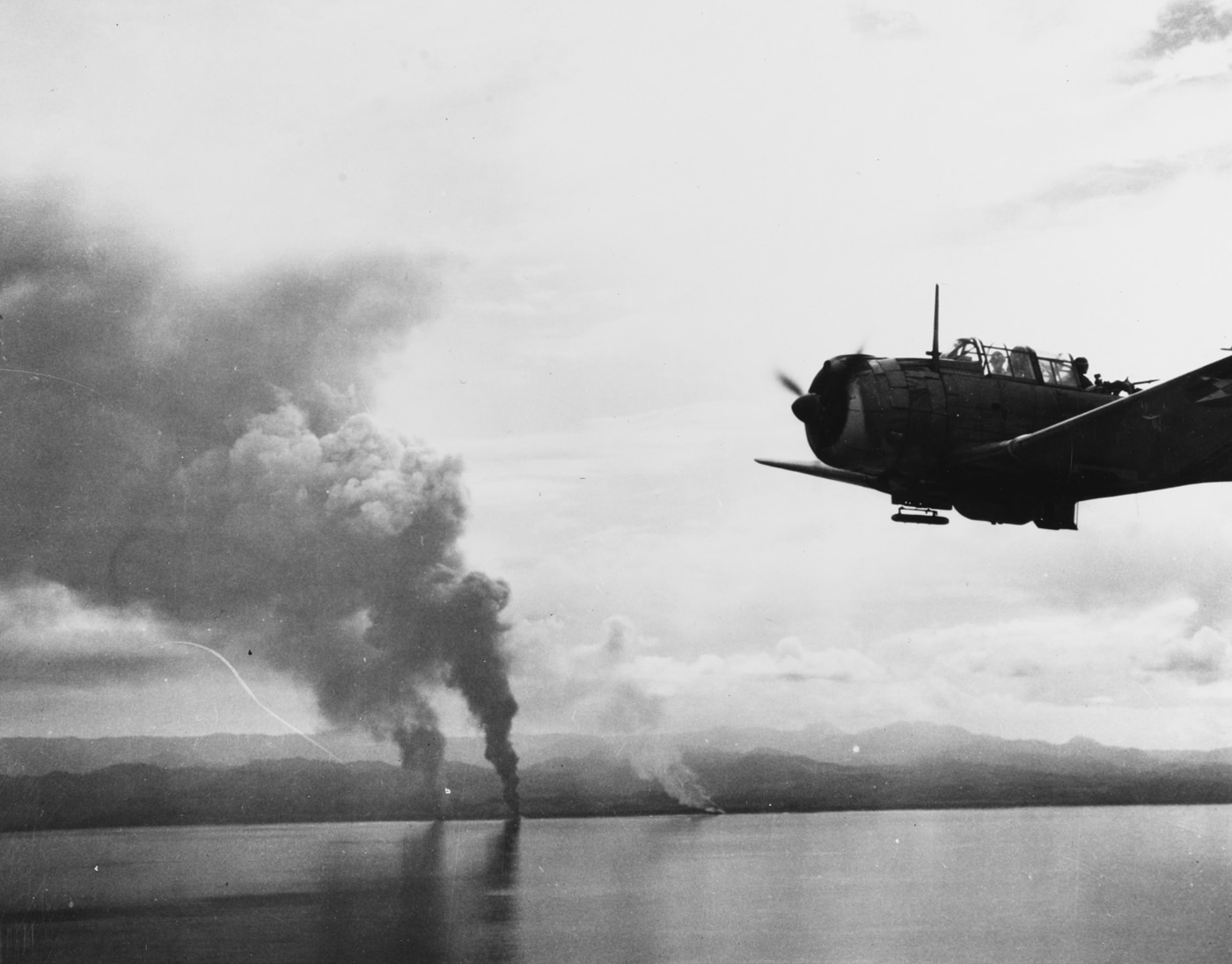
Though 40 of the dive-bombers were lost, the survivors — each armed with a single 1,000-pound (454 kg) armor-piercing bomb — pressed home the attacks on the carriers Kaga, Akagi, and Sōryū. The three were set ablaze in the space of just three minutes, while a fourth carrier, Hiryū, was sunk in a subsequent wave.
That turned the tide of the war in the Pacific.
In addition to its success as a dive-bomber, one Navy SBD crew managed to shoot down seven Japanese A6M “Zero” fighters in the space of just two days.
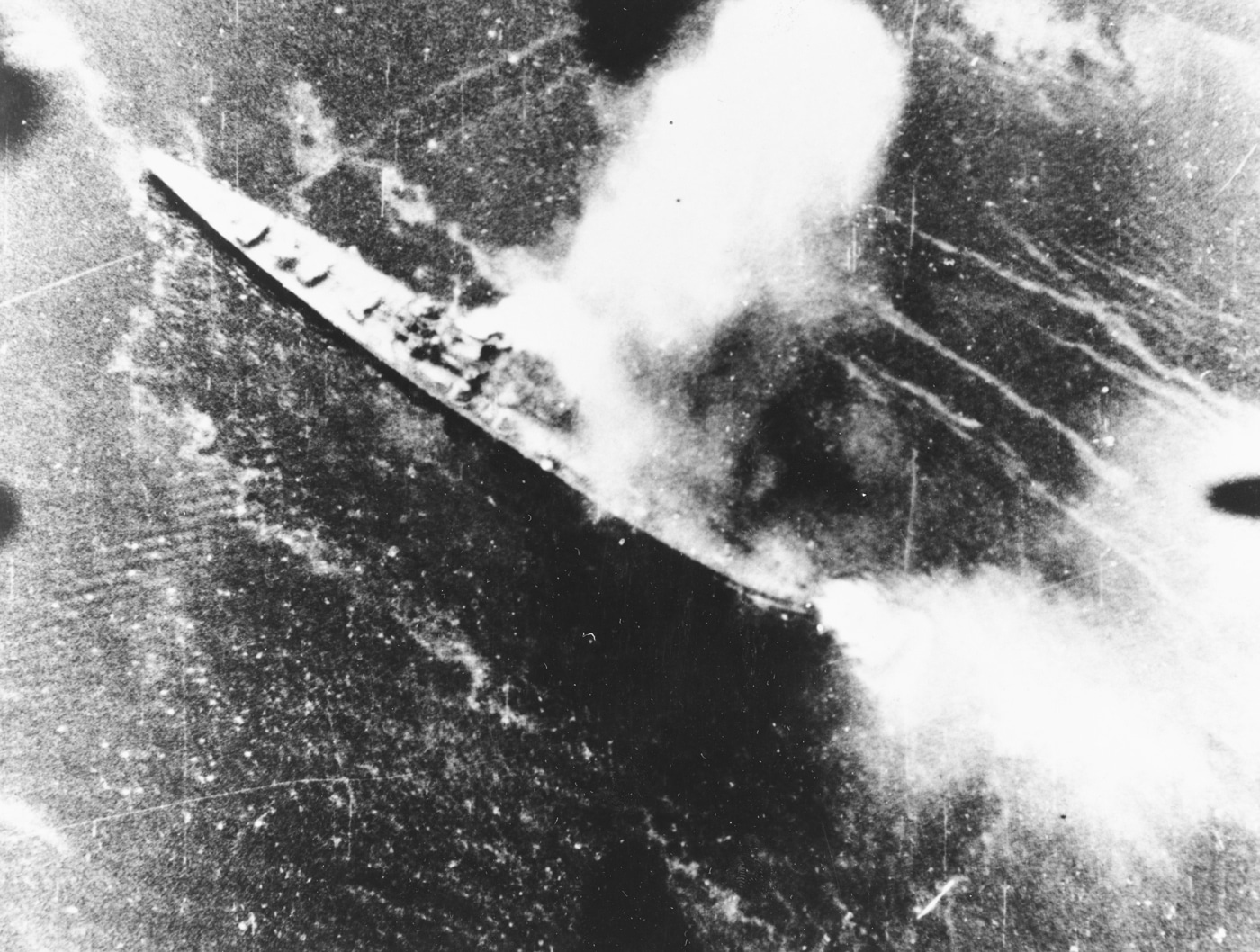
Even as more capable U.S. aircraft entered service — notably the Curtiss SB2C Helldiver — the SBD Dauntless was employed in combat at Rabaul, Guadalcanal and the Solomons, and Truk. The Helldiver never proved as successful as the SBD, yet once it was on the scene, the Dauntless was largely relegated to anti-submarine patrol and close air support duties.
While the aircraft was most infamous in its U.S. Navy role during World War II, a total of 20 United States Marine Corps squadrons also flew the Dauntless. In addition, it was also operated by the United States Army Air Forces as the A-24 Banshee, and the dive-bomber saw service with the 27th Bombardment Group at New Guinea and with the 531st Fighter Bomber Squadron at Makin.
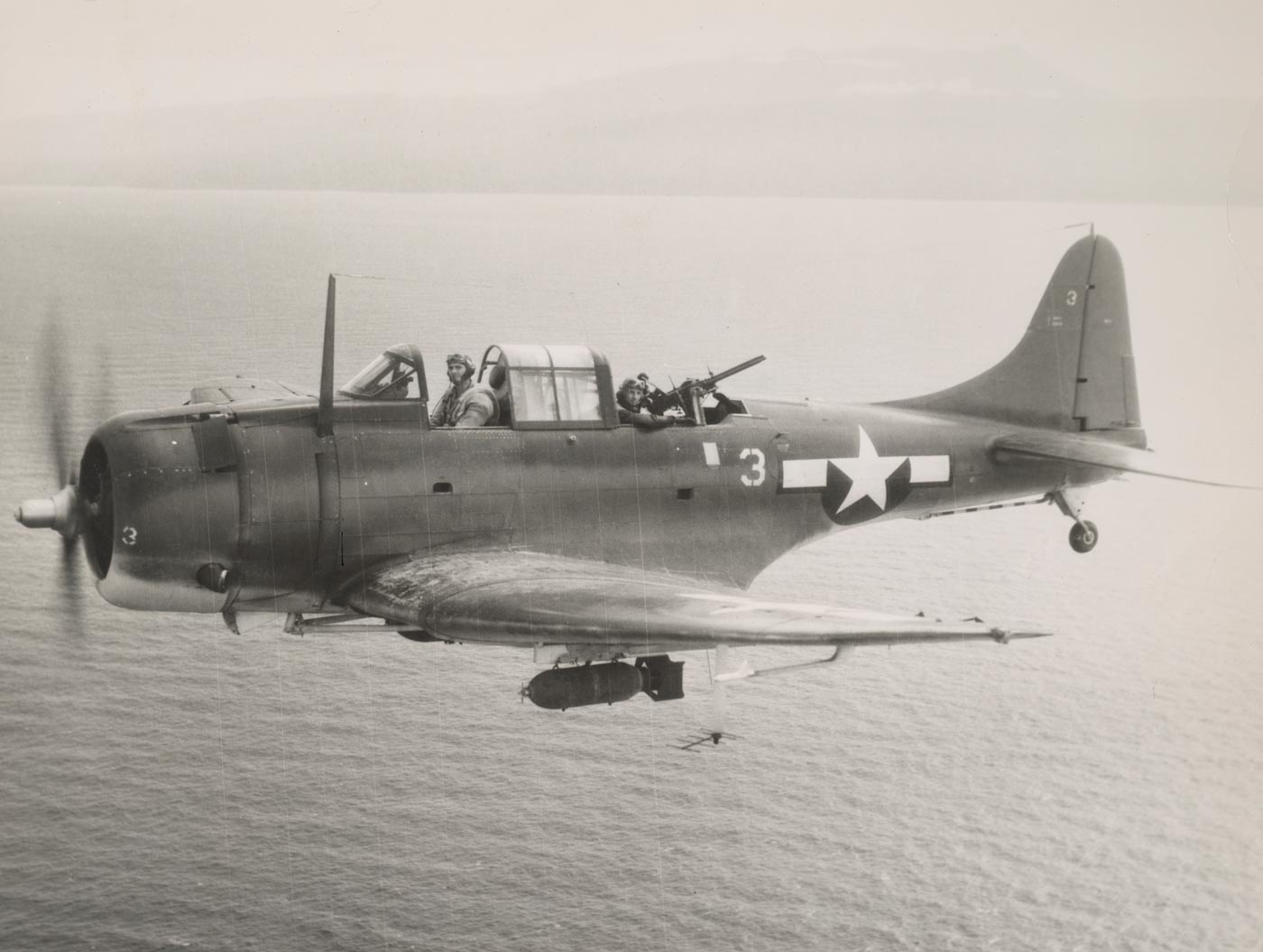
However, USAAF pilots often found that they could not outmaneuver aggressive Japanese fighters. Where the rear-seat gunner had been highly effective with U.S. Navy aviators, the Army Air Force had far less success. In fact, casualties of the A-24 Banshee were so high that it was quickly withdrawn from front-line service.
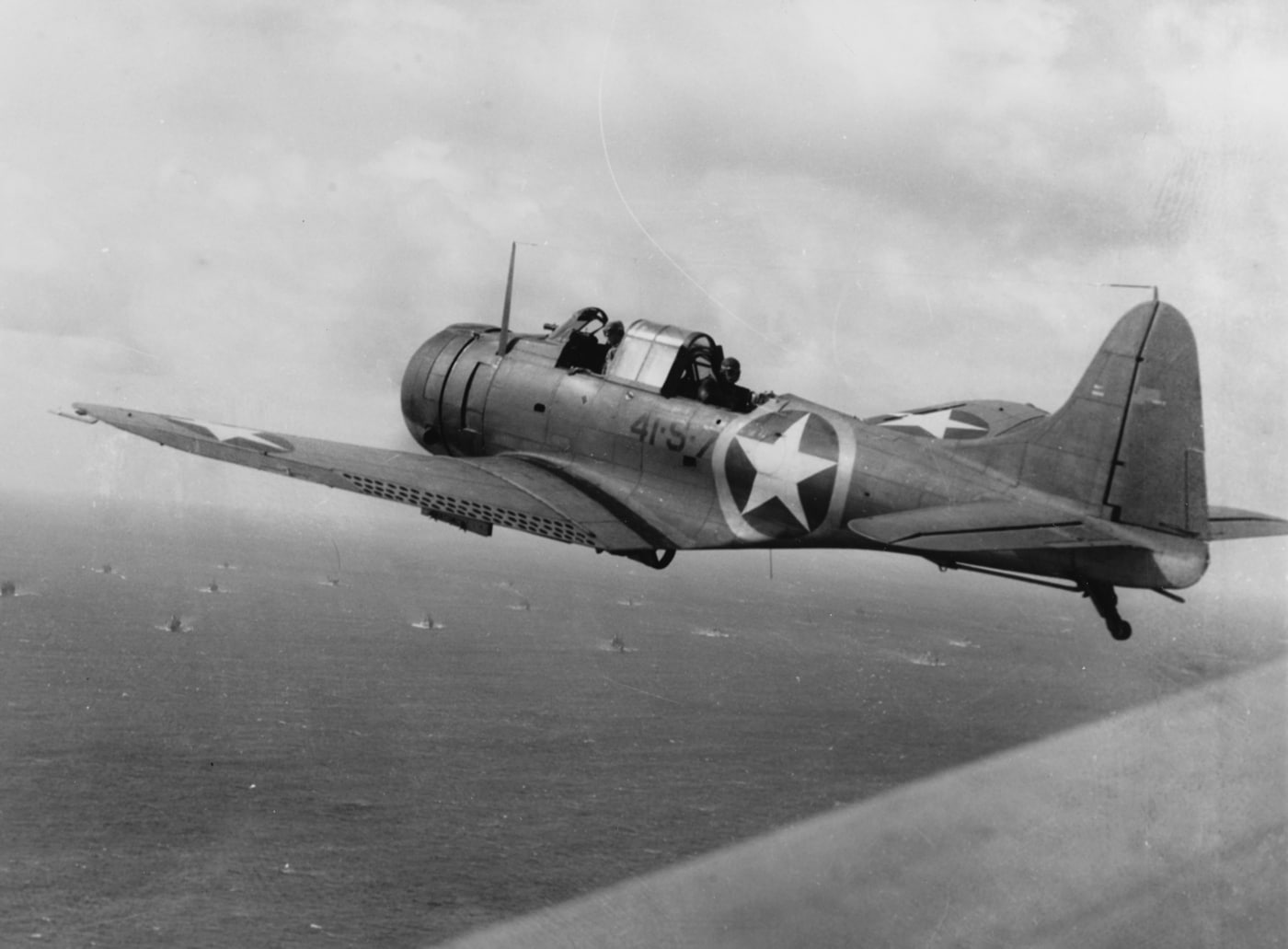
The UK acquired nine aircraft for testing, but perhaps based on the performance with the USAAF, it ultimately rejected it for service. By contrast, the Royal New Zealand Air Force employed a number of SBD-3, SBD-4 and SBD-5 models from U.S. Navy and USMC stocks. Those aircraft saw action at Bougainville with great success.
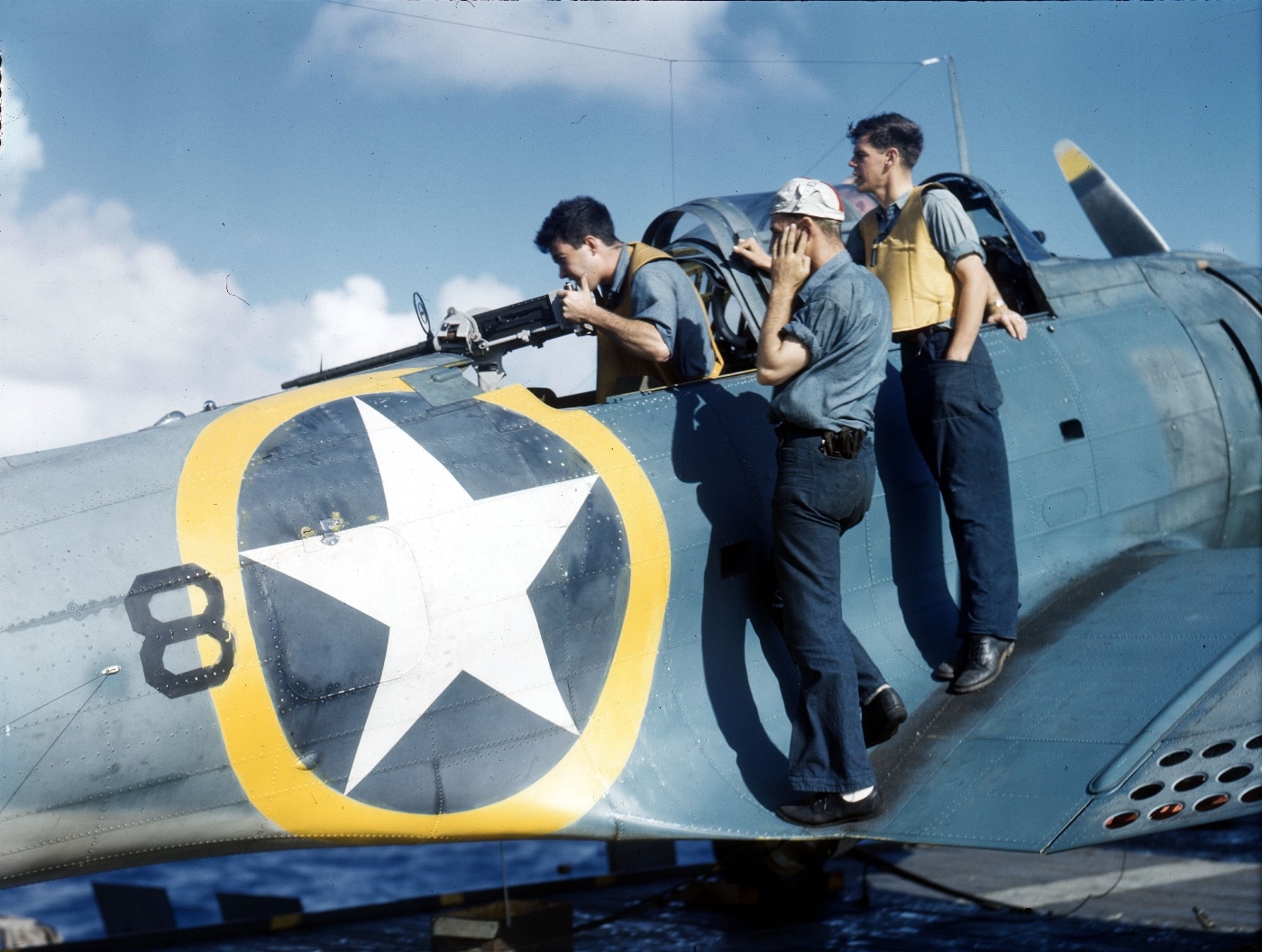
The French military also employed A-24s and SBD-3s at Agadir, Morocco, and later in metropolitan France against retreating German forces in 1944. France continued to operate the dive-bomber after the war, while it also saw service in the air forces of Chile, Mexico and Morocco. The final Dauntless dive-bombers remained in service with the Mexican Air Force until 1959.
Though in total 5,936 were produced in all configurations between 1940 and 1944, today, there are only around half a dozen A-24s and SBDs that remain airworthy. An additional 20 or so aircraft are now on display in museums in the United States.
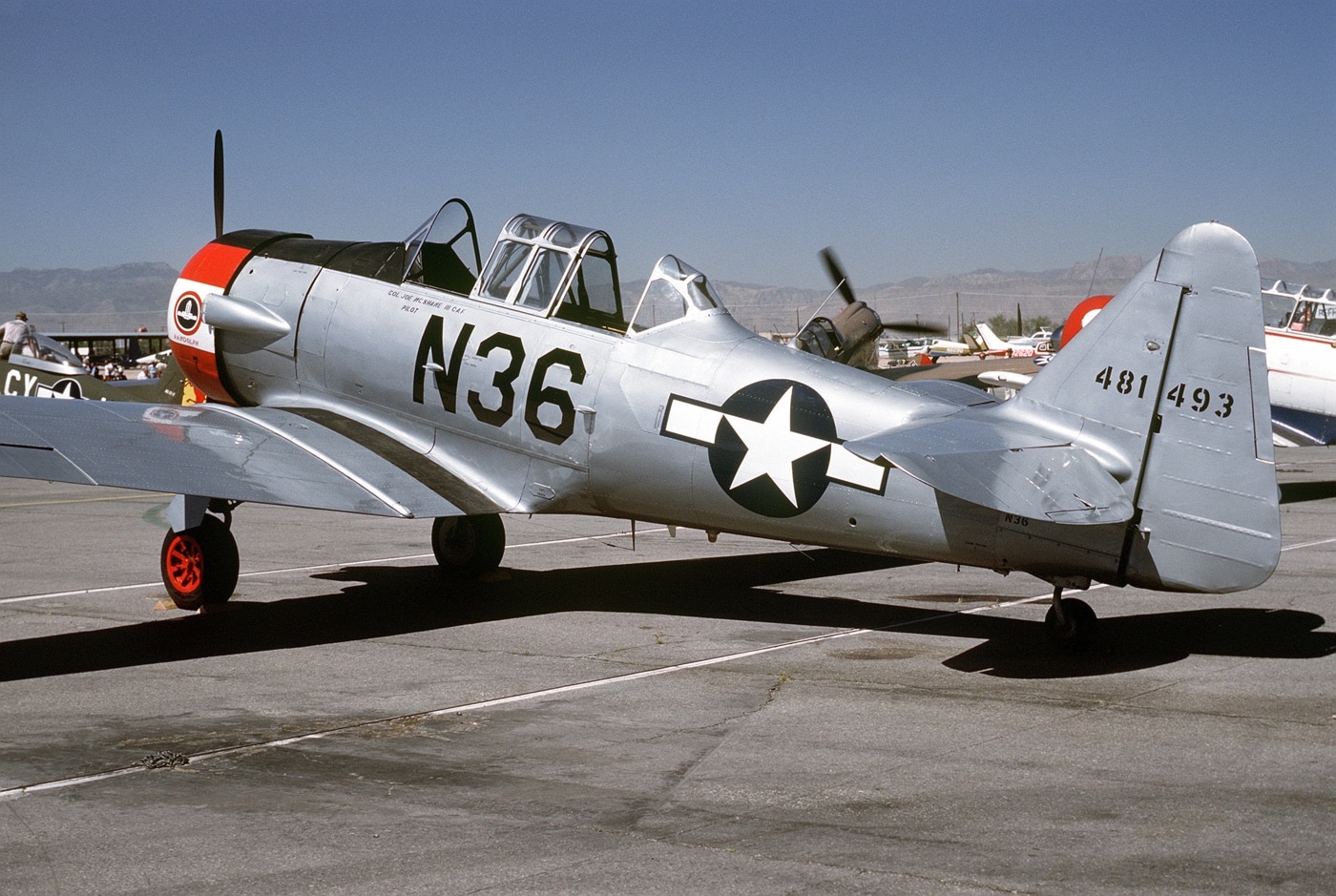
An SBD-2 that is a “veteran” of the Pearl Harbor attack and the Battle of Midway is in the collection of the National Naval Aviation Museum at Naval Air Station Pensacola, Florida. Another SBD-2 is in the Pearl Harbor Aviation Museum at Ford Island, Hawaii, while an SBD-3 is in the collection of the Air Zoo in Kalamazoo, Michigan, and one is also on display at the National World War II Museum in New Orleans, Louisiana.
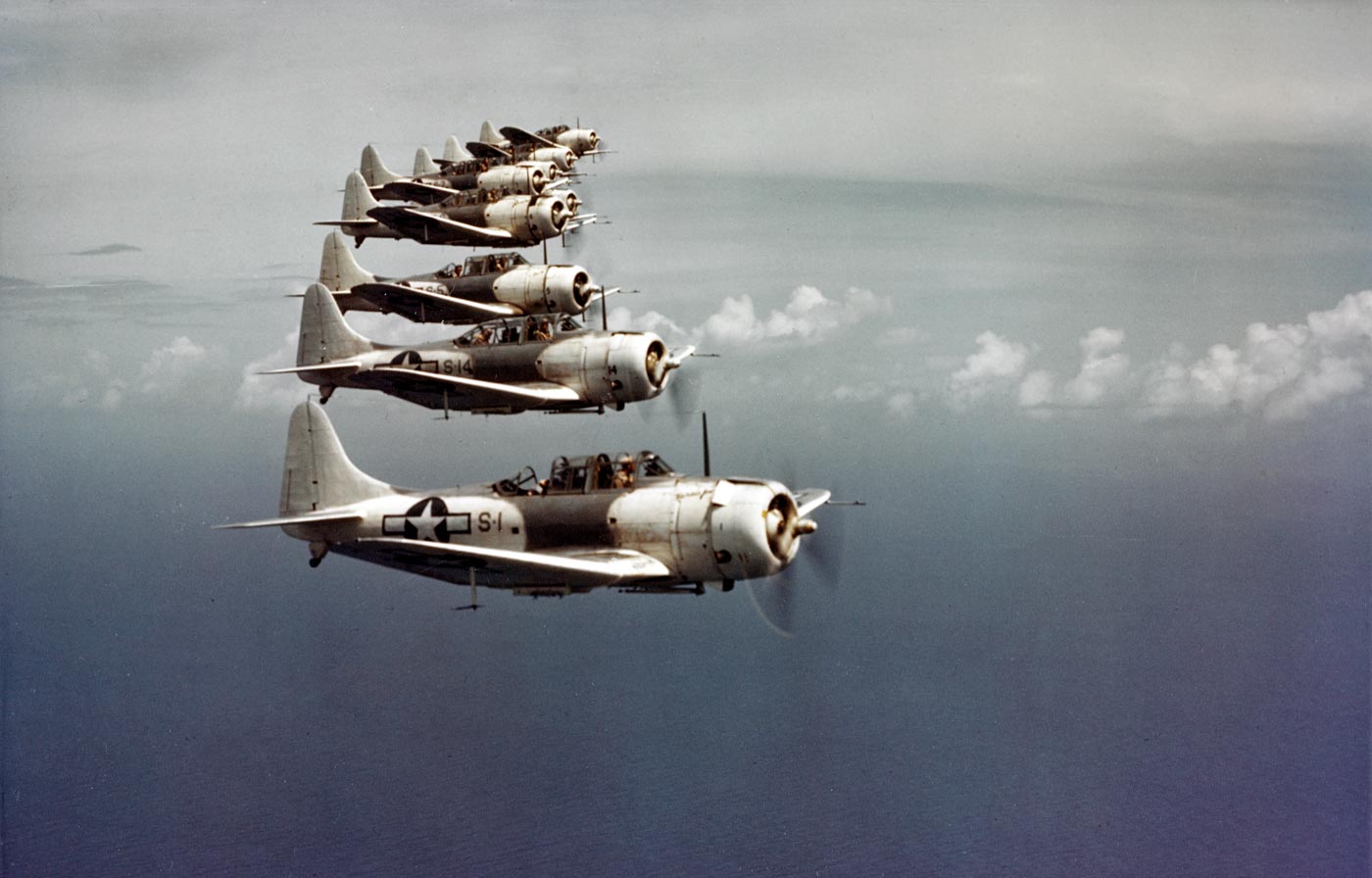
Today, the SBD is best remembered as the dive-bomber that delivered the fatal blows to the Japanese carriers and truly helped turn the tide of the war.